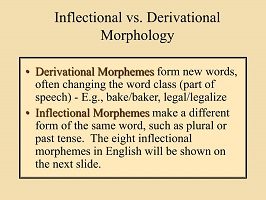Inflectional morphemes examples types and characteristics
Inflectional morphemes
The inflections are one of two types of morphemes in the world. These are the ones that go to the end of the word. Their function is to define the number and gender. In this article we will provide you the examples of inflectional morphemes.
Morphemes are the fragments of words that are modified to change the meaning. That is, they are the part of the word that is changed to create the word families.
For its part, the lexeme is the fragment of the word that does not vary so that the meaning changes. Together they are the two units that come together so that the word makes sense.
For example, in the word “house” the lexeme is CAS, while the morphemes are the fragments that are added to change its meaning, such as ITA (cas + ita = little house)
Morphemes are studied by morphology, one of the branches of linguistics. The different combinations between lexemes and morphemes are what create the word families.
For example:
– cas + ota = casota
– cas + ero = home
– cas + ucha = hovel
Likewise, what are examples of inflectional morphemes?
Examples of applying inflectional morphemes to semantic unit of a text. In other words are adding -s to the root dog to form dogs, or adding -ed to wait to form expected. An inflectional morpheme changes the form of a word. English has eight inflections.
Likewise, what is an example of inflection? Inflection refers to a word formation process in which items are added to the basic form of a word to express grammatical meanings. They are used to express different grammatical categories. For example , the inflection -s at the end of dogs shows that the noun is plural.
Also, what is an example of a morpheme?
A “base” or “root” is a morpheme in a word that gives the word its main meaning. An example of a “free base” morpheme is woman in the feminine word. An example of a “bound base” morpheme is -sent in the word dissent. An affix can be derivational or inflectional.
What are the eight inflectional morphemes?
There are eight inflectional morphemes in English. They are all suffixes. Two inflectional morphemes can be attached to nouns, -‘s (possessive case), – (and) s (plural). Four inflections can be attached to verbs, – (e) d (past tense), -ing (present participle), -en (past participle), -s (3rd person singular).
Types of inflectional morphemes
– Nominal morpheme
These are the ones that apply to nouns or adjectives. Thus they modify the gender and the quantity of these. In Spanish gender is defined by “a” for feminine and “o” for masculine.
– bitch + a = bitch
– dog + o = dog
While the “s” at the end of the word is indicative of the plural.
– dogs + os = dogs
– bitch + ace = bitches
– Verbal morpheme
These are the ones that affect the meaning of verbs, and are defined by verb conjugations.
These are more varied than verbal inflectional morphemes. They indicate the time, quantity, people, among other things.
This means that through verbal inflectional morphemes the circumstances in which the verb is executed are defined.
For example:
– corr + er = infinitive verb
– corr + going = gerund verb
– corr + ido = verb in participle
– corr + iste = verb in the past, second person singular
Examples of inflectional morphemes
Below are the examples of inflectional morphemes.
Example 1
– child + o = child
– boy + a = girl
In this case, they would be inflectional morphemes that affect gender.
– children + you = children
– girls + as = girls
In this, they would be inflectional morphemes that affect the number.
Example 2
– gat + a = cat
– gat + o = cat
In this case, they would be inflectional morphemes that affect gender.
– gat + os = cats
– gat + as = cats
In this, they would be inflectional morphemes that affect the number.
Example 3
– apple + o = apple tree
– apple + a = apple
In this case, they would be inflectional morphemes that affect gender.
– apple + os = apple trees
– apple + as = apples
In this, they would be inflectional morphemes that affect the number.
We hope you have noted the examples of inflectional morphemes.
